Rethinking glyphosate
Last year the Environmental Protection Authority called for information on the popular weed killer glyphosate, but are they dithering to avoid a risk assessment? Bonnie Flaws investigates.
We hope you enjoy this free article from OrganicNZ. Join us for access to exclusive members-only content.
The Environmental Protection Agency (EPA) is currently reviewing information provided by the public on the herbicide glyphosate after issuing a call for information last year, which could lead to reassessment, including a full risk assessment.
The controversial weed killer glyphosate, a broad-spectrum herbicide in the organophosphate class, is the most widely used weedkiller in the world, and certainly in New Zealand. It has been used here since the 1970s. It is the active ingredient in formulations referred to as GBHs (glyphosate-based herbicides), of which there are 89 approved mixtures in New Zealand, including the ubiquitous Roundup.
Despite a 2018 class-action lawsuit in the United States that awarded US$289 million to a groundskeeper who developed terminal cancer from using Roundup, in New Zealand the EPA still classifies glyphosate as a “low-toxicity herbicide”.
EPA General Manager Chris Hill said the call for information had been initiated to get a better understanding of how GBHs are used in New Zealand, “with a view to making a decision about whether a reassessment is necessary, and if so, to pursue grounds for reassessment”.
Many responders were professional users who said it was safe and highly beneficial if used properly. About 60 per cent of responders were non-users who said it was a toxic poison that should be banned or restricted.
No decision has yet been made, but it appears the EPA is waiting to see whether the European Chemicals Agency and the European Food Safety Authority decide to go ahead with a reassessment – a decision that was recently deferred until next year. “The information we have received from our call for information better prepares us to assess the European findings and consider further actions for New Zealand,” Hill says.

“There is no scientist in
New Zealand that is paid to
research pesticides and
pesticide risk.”
JODIE BRUNING
What we do know and what we don’t
The use of GBHs has broadened significantly since their initial introduction as weedkillers for agricultural crops. They are now widely used by councils on roadsides where our children walk to school and can run into drains, to kill weeds in waterways, and as a pre-harvest desiccant to dry out crops under threat from ill-timed rain, sociologist Jodie Bruning points out.
This last use gives farmers more control over when they can harvest, and essentially sees cereals and pulses doused with the chemical just ahead of harvest, leaving higher residues on crops. It is difficult to get information about how common this practice is in New Zealand.
Similarly, we don’t know how much glyphosate is applied in New Zealand every year, as we stopped reporting this to the Food and Agriculture Organisation back in 2009, Bruning tells me. However, a recent study from the Centers for Disease Control and Prevention in the US found that more than 80 per cent of urine samples drawn from children and adults in a study contained glyphosate.
Environmental and health impacts
Legal discovery in court cases brought against Monsanto, the manufacturer of Roundup, in the US have brought some stark realities to light about glyphosate toxicity, Bruning says.
In particular, it’s now known that GBH residues on the skin absorb in and pool under the dermal layer, which is how farmers have long-term exposure. “The EPA says if you are fully protected you’ll be safe. They have not communicated risk to farmers on glyphosate. You still see farmers out there in jandals, and roadside sprayers where kids are walking home from school,” says Bruning.
Then there is the risk to the soil web. A recent report from the UK Soil Association found that evidence of glyphosate’s impact on the soil and soil life was inconclusive: “Research indicates potential impacts in increasing crop diseases, changing the composition and functioning of soil microorganism species and ecosystems, and recently published studies are showing a negative impact on earthworms. Scientists working in this field are calling for future research to be carried out. This is urgent given the widespread and heavy use of glyphosate worldwide.”
But as Professor Jack Heinemann, a geneticist at the University of Canterbury points out, glyphosate is a biocide, and kills more than just plants. It also kills microbiota.
Heinemann’s work shows that herbicides, including GBHs, cause bacteria to become resistant to clinical antibiotics. This literature is not being considered by regulatory agencies, including the EPA.
Risk assessment (which for glyphosate has not been done) tends to look at a chemical’s direct toxicity to humans or animals, or pollinators like bees. Regulators have not thought about how herbicides change microbiota to become either more receptive to disease or cause bacteria to become less responsive to antibiotics, he says.
“Glyphosate and other herbicides constitute some of the largest releases of synthetically developed chemistry [in the world], so the exposures are broad. We also know that antibiotic resistance is happening way faster than we had hoped or predicted.
“This additional chemical exposure gives us some explanatory power as to why antibiotic resistance is so pervasive and seemingly irreversible, so we think they should be taken account of in risk assessments.”
And of course, the International Agency for Research on Cancer (IARC), the world’s leading authority and gold standard on carcinogenicity, famously declared glyphosate to be a probable cause of cancer in humans back in 2015.

“Glyphosate and other
herbicides constitute some of the
largest releases of synthetically
developed chemistry, so the
exposures are broad.”
JACK HEINEMANN
New Zealand’s “no-science” problem
Bizarrely, instead of relying on the IARC’s findings, the EPA commissioned its own report, by a single author – a toxicologist with no background in epidemiology – which concluded that glyphosate was unlikely to be genotoxic or carcinogenic to humans, and did not require reclassification under the Hazardous Substances and New Organisms (HSNO) Act. This report was roundly criticised in two subsequent papers.
A 2017 paper from the Green Party, authored by Bruning and former MP Steffan Browning, called out the EPA’s decision to ignore IARC’s findings, concluding that the science and opinion that it primarily relied on in its assessment was supplied by industry, and based on unpublished data instead of the independent, peer-reviewed science that informed IARC’s classification of glyphosate as a probable human carcinogen.
Then, in 2018, scientists at the Centre for Public Health Research published a paper asking if the EPA was “lost in the weeds”. One of the authors, Andrea T. Mannetje, had been part of the 17-strong IARC panel in 2015.
This paper, which Bruning describes as the most important paper on glyphosate to have been published in New Zealand, also drew attention to the EPA’s reliance on non-peer-reviewed industry-funded studies, making it impossible to evaluate its validity and conclusions.
Bruning says there is no evidence in the EPA’s archives that it has ever done a risk assessment of glyphosate. Nor has its subcommittee ever met since the IARC findings to decide if there was new evidence of toxicity that would require a formal risk assessment under the HSNO Act. “This is part of New Zealand’s ‘no science’ problem. There is no scientist in New Zealand that is paid to research pesticides and pesticide risk.” The EPA’s call for information was essentially “dithering”, when it ought to be conducting a thorough risk assessment, Bruning says.
“The Parliamentary Commissioner for the Environment has drawn attention to how bad our science and monitoring system is. It’s deplorable. Science is now captured within the Ministry of Business, Innovation and Employment.”
The Parliamentary Commissioner for the Environment, Simon Upton, in a recent report, questioned the adequacy of the information on which we base important environmental decisions. He recommends, among other things, that the Ministry for the Environment develop regulations to require and empower the EPA to collate, collect and report on the quantity and use of chemicals in New Zealand. With this information, we could do quality environmental monitoring.
Upton concludes that our regulatory system does not always ask the questions that need to be asked, and that “it needs a basis for providing better scrutiny of the chemicals New Zealand uses a lot of and which have the potential to cause harm”.

Sign our petition
Support the Soil & Health
Association in their campaign
to restrict the use of GBHs.
Read more below.
soilandhealth.org.nz/glyphosate
Sign our petition
Since July 2020, the Soil & Health Association (publisher of Organic NZ) has been campaigning the government to restrict the use of GBHs in the following ways:
- Banning the use of glyphosate in public places and around waterways.
- Banning foliar sprays (pre-harvest) of glyphosate formulations on human and animal feed crops.
- Conducting a first-ever risk assessment of the active ingredient glyphosate, and the retail formulation sold in shops, using independent published and openly available scientific data
Sign our petition: soilandhealth.org.nz/glyphosate
Countries that restrict or ban glyphosate
After the International Agency for Research on Cancer declared glyphosate to be a probable human carcinogen in 2015, many countries have made moves towards an outright ban (there have been delays and pushback in numerous cases, however). These include Bahrain, Malawi, Thailand, Vietnam, Sri Lanka, Oman, Kuwait, United Arab Emirates, Qatar, Saudi Arabia, St. Vincent and the Grenadines, Bermuda, Austria, Belgium, Czech Republic, Denmark, France, Italy and The Netherlands.
Another 21 countries have restricted the use of glyphosate at the district level or issued statements of intent for a future ban or use reduction.
Non-toxic garden-weed management
- Before creating a new garden, kill off any grass or weeds by laying down thick pieces of cardboard or old carpet for a couple of weeks.
- Mulching heavily with pea straw, grass clippings, seaweed and bark helps suppress weeds and builds
up organic matter in the soil. - Pull them out little and often before they have a chance to go to seed. Focus your efforts on the true baddies, like strangling convolvulus.
- Use weeds as a natural mulch by chopping and dropping them. Just remove any seed heads or flowers.
- Avoid composting troublesome weeds that might regrow, such as the bulbs of oxalis and onion weed. Instead, rot them down in a sealed bucket of water for six months, then add it to your compost or dilute it with water and apply it as a fertiliser.
- Plant densely so your soil is covered and weeds have to compete for their place with the plants you do want.
- If you can’t beat ’em, why not eat ’em! (See our story on page 40.)
- Some local councils allow you to opt out of weed spraying on your berm. Check out their websites.
Bonnie Flaws is a freelance journalist and writer based in Napier. She grows an organic vegetable garden and shops organic wherever her budget allows.





